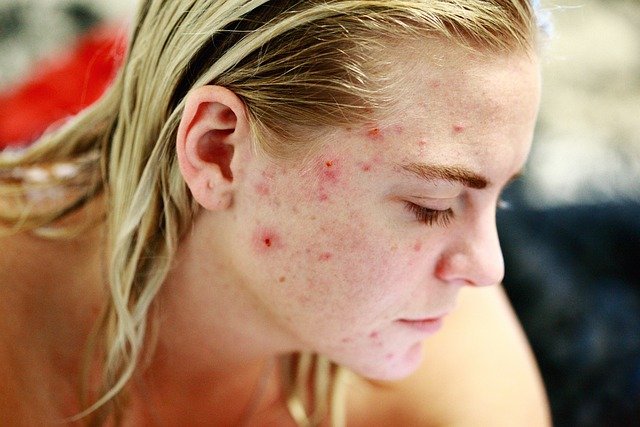
Acne is a widespread problem that can also be controlled through the correct diet. So let’s see what to eat and what to avoid to improve acne.
Acne is an unpleasant condition characterized by inflammation of the pilosebaceous bulb and the consequent frequent appearance of the pimple. This pathology is often associated with a cosmetic defect, but in some cases, for example in the case of cystic acne, it is accompanied by pain and burning at the site of the inflammation.
This disorder is very common during adolescence, a sign that there is a connection with the hormonal productions that characterize that period and generally, but not always, subsides and disappears in the young adult. In this case it is about juvenile acne. Acne is also one of the main reasons for consulting with the dermatologist, whose task is to recommend and prescribe creams and any medications to relieve the skin.
However, there are also other measures that can be adopted to improve the situation: for example, although there is no globally recognized diet for acne, there are several evidences that allow us to understand which foods not to eat to fight acne. In this article we will present the main causes of this pathology and the most effective dietary precautions.
Acne: what are the causes?
Although acne has been a widespread condition that has been known for many years, all the causes that lead to it are not yet known. Among the known factors connected to acne lesions there are certainly genetic ones, combined with hormonal imbalances and in particular conditions of hyperandrogenism.
In fact, from a dermatological point of view, acne lesions are due to an excessive production of sebum at the level of the pilosebaceous bulb which remains so clogged, to the proliferation of some bacteria such as Propinebacterium acnes (now better known as Cutibacterium acnes), to the excessive keratinization of the follicles and inflammatory mechanisms. More recently, acne has also been linked to diet and excessive production of another hormone, IGF-1, whose concentration has again been linked to sebum production.
A relationship between the appearance of pimples and food intolerances, intestinal dysbiosis and stress has also been hypothesized. It is therefore very important to check and correct some habits to feel better and thus benefit not only the skin, but also the whole body. Let’s see now what is the correlation between diet and acne.
Why nutrition can affect acne
The role of diet in acne control has been ambiguous for many years: several authors hypothesized its role in the etiopathogenesis of acne, but few studies were able to prove this association. However, observing non-Western populations who followed diets without sugary or processed foods, it was realized that acne is a typical condition of the most industrialized countries and is therefore connected to the so-called Western diet.
It is a diet rich in foods with a high glycemic index and in dairy products and its derivatives: all these foods lead to an increase in insulin-like growth factor or IGF-1, which we have already seen to be related to acne lesions. Some authors, in particular, define this hormone as the central actor of acne.
Diet for acne: what to eat and what to avoid
The foods most connected to the development of acne are refined carbohydrates with a high glycemic index and dairy products.
Regarding the first category, it has been shown that a low glycemic load diet (i.e. a diet with reduced carbohydrates and complete meals) leads to a reduction in free androgens and insulin. A diet with both low glycemic load and low glycemic index also reduces IGF-1 levels. Unrefined carbohydrates are therefore recommended, such as all whole grains and their derivatives; vice versa it is not recommended to consume simple sugars, sweets, white bread, pasta and rice that are not wholemeal.
The consumption of milk has also been linked to an increase in acne: some studies have shown that this connection was such only for the consumption of skimmed milk and others for the consumption of any type of milk. The cause could be linked to the insulin index of milk or the fact that the consumption of milk greatly increases the production of insulin in the 2 hours following consumption. In a diet for acne, milk should therefore be limited; it does not seem necessary to eliminate other dairy products such as yogurt as this limitation is not supported by the literature and vice versa the use of probiotics, such as those present in yogurt, seem to improve acne lesions.
It has also been shown that supplementation with omega 3 helps to improve the inflammation created by acne and therefore to relieve the skin: green light therefore to the foods that contain it, such as dried fruit (in particular walnuts and almonds), oil seeds and caught fish.
What to eat and drink
We have seen together which food groups it is better to limit and which ones it is better to add in your diet, if you suffer from acne. Therefore, we remind you that whole grains and foods rich in omega 3 are among the foods to be preferred (eg blue fish, dried fruit, chia seeds and flax seeds). All types of vegetables are also to be preferred, extra virgin olive oil and less sugary fruit (e.g. strawberries, berries, kiwis, citrus fruits) which, in addition to being beneficial foods for the whole organism, provide substances anti-inflammatory that can help to relieve the skin.
Advice on what to eat for breakfast
We have shown you that milk is one of the foods that cause pimples. It is therefore logical to ask what to eat for breakfast to fight acne. Among the recommended drinks we certainly find green tea, with anti-inflammatory properties, as well as karkade, which is pleasant even in the summer season. Some herbal teas can also help with acne, such as those based on burdock or dandelion.
Together with these drinks we suggest you accompany a breakfast with a low glycemic index and load: you could opt for a porridge with coconut milk, whole oats, walnuts and flax seeds or for a yogurt with low-sugar fruit and dried fruit or, again, for a savory breakfast with black bread, avocado and smoked salmon.
What to avoid: Here are the foods that can cause pimples
Let’s briefly review together what to avoid in case of acne: among the foods to limit the most we find sugars and all the products that contain them. Let’s pay attention to the different ways in which sugars present themselves: in fact, in many industrial products we will find glucose syrup, fructose syrup, fructose, rice syrup etc… these are always simple sugars with a high glycemic index, therefore they must be reduced.
As for chocolate, which is often mentioned as one of the foods that cause pimples, a brief distinction needs to be made. If we are talking about milk chocolate and / or with added sugars, this should be avoided as it can actually negatively affect the appearance of brucoli. The bitter extra dark chocolate, on the other hand, is not related to their appearance and can be consumed (in moderation) even in case of acne.
At the same time, remember that even the group of refined carbohydrates worsens acne: then replace white bread with wholemeal or rye bread, pasta with wholemeal alternating with other cereals such as spelled and quinoa, rice with brown rice or basmati.
Another food to limit is milk: we can replace it with yogurt and other drinks such as green tea. The replacement with vegetable drinks is not always indicated as, sometimes, they may contain fats and additives that could prove to be enemies of the skin, as well as often added sugars. In this case it is good to choose quality products and possibly sugar-free add, even better if homemade!
Finally, be careful to limit bad quality fats: if foods rich in omega 3 and olive oil, avocado and olives are skin-friendly foods, other vegetable oils (corn, peanut, sunflower, rapeseed…) they can help support inflammation, especially when exposed to high temperatures. For this reason, we recommend that you also limit fried foods. It is also good to limit the consumption of alcohol and pay attention to hydrogenated fats and margarine.
Table: foods yes and foods no
Here is a summary table where you can see which foods to limit and which ones to prefer in case of acne.
Yogurt and Kefir Milk Oil seeds and dried fruit Fried food Alcoholic
| Foods to prefer: | Foods to avoid or reduce: |
| Whole grains | Sugar |
| Legumes | Syrups |
| Vegetables | Industrial fruit juices |
| Low-sugar fruit | Potatoes |
| Extra virgin olive oil | White bread |
| Dried fruit | White paste |
| Caught fish | White rice |
| Yogurt and Kefir | Milk |
| Oil seeds and dried fruit | Fried food |
| Alcoholic |
5 foods that help reduce the problem
After having seen the guidelines on what to eat and what to avoid with acne, let’s see some foods that can be considered, due to the anti-inflammatory effect they have, a valid support in the fight against pimples.
1. Anchovies
These small fish are readily available in all fish shops and are frequently caught in our sea. They are also consumed with the skin, which contains the highest concentration of omega 3, the anti-inflammatory fatty acids that we talked about in one of the previous paragraphs and related to the reduction of the inflammatory state.
2. Flax seed
Flax seeds are, among the oily fruits, the richest in omega 3 and can be considered an anti- inflammatory food. They are to be used freshly ground and for this reason we suggest you equip yourself with a pepper mill. They can be eaten at breakfast, for example added to yogurt, to the extent of one or two coffee spoons.
3. Extra virgin olive oil
Our extra virgin olive oil, the main food of the Mediterranean diet, is rich in polyphenols and vitamin E, components with anti-inflammatory properties that can help relieve the skin.
4. Yogurt and kefir
These foods are rich in probiotic microorganisms and their regular use allows to support the good balance of our microbiota, or our bacterial flora. Probiotics improve insulin sensitivity and reduce the release of inflammatory cytokines in the skin. Furthermore, probiotics allow to modulate the anti-inflammatory response of our immune system, thus being useful in all inflammatory conditions, even low-grade, including acne.
5. Green tea
Green tea can also be considered to help with acne. Not only because it allows us to replace milk as a breakfast drink, but because a good consumption of green tea has anti-inflammatory properties and helps support liver activity.
The role of the liver in the onset of acne
There is not much evidence in the literature that fatty liver or other liver disease is related to acne. However, it is important to underline that the liver is an organ responsible for eliminating various substances that we introduce with the diet and some hormones.
The liver also plays an important role in regulating blood sugar levels – all of these reasons could link poor liver health to worsening acne. It is important to reiterate, however, that there is no scientific evidence or studies to support this thesis. In any case, cleansing the liver with a proper diet and drinks could help us get better!






